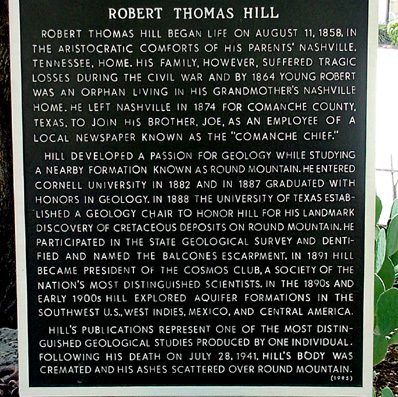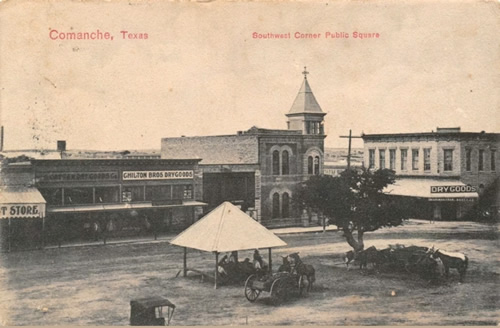On the Southwest Corner of Comanche's Square, Comanche, Texas history. (original) (raw)
Choosing just one among Comanche's favorite historical items is not easy. There are several possibilities grouped on the southwest corner of Comanche's square. The double pen log cabin set beneath the Fleming Oak is identified as the only surviving log courthouse in Texas. One of its rooms served Comanche County during the years the county seat was located at Cora, some 12 miles southeast of Comanche. Later it was relocated slightly, a second room added, and it became a residence for many years. A hearty stand of Texas Historical Commission markers is gathered under the Fleming Oak where they point up local events and personalities.
The Fleming Oak on the SW corner of Comanche's square
TE Photo, August 2002
One of them recounts an 1861 night raid in bright moonlight when Indians made off with most of the horses in town. They were pursued by a sizeable group of local men who reputedly killed 19 Indians after a lengthy chase. Dr. Ashbel Smith (1805-1886) was a distinguished personality, important in Texas history, and his marker cites only a few of his many achievements. His only connection with Comanche County is a 1280 acre land grant patented in 1854. A Comanche resident finally purchased the property in 1889 and Dr. Smith never saw it. Dr. Robert T. Hill's marker honors the "Dean of Texas Geology" mentioning some of his professional accomplishments and noting his Comanche County connections. The most modern marker identifies the Bicentennial Park dedicated July 4th, 1976. This small park contains four limestone columns saved from the entrances of Comanche's fourth courthouse, used between 1891 and 1939.
Continuing to flourish, the Fleming Oak shades a pleasant spot that once included one of the two town wells and a limestone watering trough carved to resemble a fish. In the course of modern paving work, the old well was uncovered. It was restored with native stone and its original circular well rock located, recovered, and donated to the project. One can look inside and admire the well's beautiful rock lining.
Tradition and history surround the Fleming Oak. William W. Fleming and his sixteen year old son, Martin V. reputedly camped near the tree as they passed through the area about 1854 freighting on the Ft. Gates/ Ft. Phantom Hill Road established to serve the short-lived military post located above modern Abilene. It was a prospecting trip, of sorts, before the town of Comanche was established. The Fleming family was living in Williamson County in 1850 at Georgetown but they relocated about 1854 to a home near the site of modern Killeen.
Martin V. Fleming apparently visited in Comanche again in the late 1850s as he returned to his Bell County home from a deer hunt. He learned of the Civil War while in Comanche and joined Co. G., First Texas Cavalry under Col. Thomas C. Frost in May of 1861 with a group of area men who mustered in at that time.
Mart Fleming, wounded twice, was discharged on disability in June of 1863 but he apparently did not return directly to Comanche. He lived briefly in Mexico after the Civil War but settled in Brenham about 1866. Some relatives lived in Washington County and there he was married to his second wife, whom he brought to Comanche in 1872. Uncle Mart, as he was affectionately known, was a stockman and a farmer with business interests in Comanche through the years. He owned and operated a furniture store and undertaking establishment for a time. He is best remembered for his meat market located on the south side of Comanche's square opposite the Fleming Oak and next to the original Comanche National Bank building. The fa�ade at the market site is being restored as part of Comanche's Main Street program.

Original Comanche National Bank Building
TE Photo, 2002
More Texas Banks
A beloved Comanche tradition arises from the city's effort to remove all the old trees from the square about 1911. The often-told tale recounts the story of Mart Fleming defending the tree with his shotgun and threatening anyone who would take an axe to it. A similar story survives about an event in 1919 when Uncle Mart, again, protected the tree from a crew paving the square.
In an interview in 1921, Fleming says he did not mention his shotgun but told those who threatened the tree that he would use his "No. 10's" on them, a reference to his boot size rather than a gun. Fleming reported that some rough words were needed but workmen laid down their tools. The shotgun defense legend has been told and retold, spelled out on an historical marker beneath the tree, and is an entrenched piece of local folklore. Another long established Comanche tradition is decorating the Fleming Oak with lights at Christmas time.
Uncle Mart died in 1928 and is buried in Comanche along with his only child, Camille, who remained single and lived at home. Uncle Mart, thrice married, is reputed to have helped rear several orphans and his family included step children as well. A colorful figure, tall, lean, and pictured late in life with a white beard, Uncle Mart continues to remind one of Comanche's past. The tree he saved is treasured.



